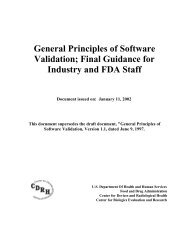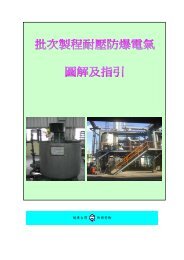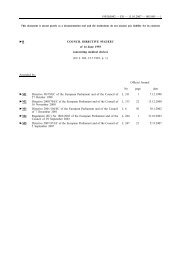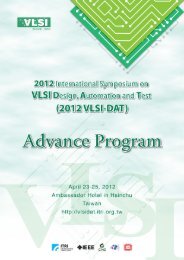Design Control Guidance - Food and Drug Administration
Design Control Guidance - Food and Drug Administration
Design Control Guidance - Food and Drug Administration
You also want an ePaper? Increase the reach of your titles
YUMPU automatically turns print PDFs into web optimized ePapers that Google loves.
e performed by device manufacturers. Rather, the manufacturer should select <strong>and</strong> applyappropriate verification techniques based on the generally accepted practices for thetechnologies employed in their products. Many of these practices are an integral part ofthe development process, <strong>and</strong> are routinely performed by developers. The objective ofdesign controls is to ensure adequate oversight by making verification activities explicit<strong>and</strong> measuring the thoroughness of their execution. Following are a few examples ofverification methods <strong>and</strong> activities.• Worst case analysis of an assembly to verify that components are derated properly<strong>and</strong> not subject to overstress during h<strong>and</strong>ling <strong>and</strong> use.• Thermal analysis of an assembly to assure that internal or surface temperatures donot exceed specified limits.• Fault tree analysis of a process or design.• Failure modes <strong>and</strong> effects analysis.• Package integrity tests.• Biocompatibility testing of materials.• Bioburden testing of products to be sterilized.• Comparison of a design to a previous product having an established history ofsuccessful use.For some technologies, verification methods may be highly st<strong>and</strong>ardized. In other cases,the manufacturer may choose from a variety of applicable methods. In a few cases, themanufacturer must be creative in devising ways to verify a particular aspect of a design.Some manufacturers erroneously equate production testing with verification. Whereasverification testing establishes conformance of design output with design input, the aim ofproduction testing is to determine whether the unit under test has been correctlymanufactured. In other words, production testing is designed to efficiently screen outmanufacturing process errors <strong>and</strong> perhaps also to detect infant mortality failures.Typically, a small subset of functional <strong>and</strong> performance tests accomplish this objectivewith a high degree of accuracy. Therefore, production testing is rarely, if ever,comprehensive enough to verify the design. For example, a leakage test may be usedduring production to ensure that a hermetically-sealed enclosure was properly assembled.However, the leakage test may not be sensitive enough to detect long-term diffusion ofgas through the packaging material. Permeability of the packaging material is an intrinsicproperty of the material rather than an assembly issue, <strong>and</strong> would likely be verified using amore specialized test than is used during production.DOCUMENTATION OF VERIFICATION ACTIVITIES. Some verification methodsresult in a document by their nature. For example, a failure modes <strong>and</strong> effects analysisproduces a table listing each system component, its postulated failure modes, <strong>and</strong> theeffect of such failures on system operation.Section F. <strong>Design</strong> Verification 3/11/97 Page 31
















